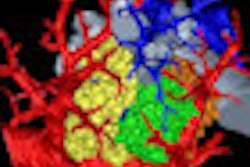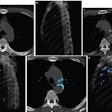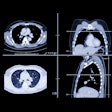"In this study, we propose the use of the marginal artery of the colon as a complementary additional axis for supine-prone colon registration," explained Dr. Ronald Summers, PhD, to AuntMinnie.com.
The marginal artery lies within the mesentery, in close proximity to the colon and to the tenia mesocolica (TM). In addition, because the marginal artery is extrinsic to the colon, it is not subject to the problems of colon collapse or residual endoluminal fluid or stool, Summers said. The marginal artery may therefore serve as a circumferential coordinate system for supine-prone registration in a way similar to that of the tenia mesocolica.
The study examined 40 polyps (average diameter, 9 mm) in 40 patients from both prone and supine virtual colonoscopy (also known as CT colonography or CTC) exams. They manually labeled the marginal artery near each polyp and projected it onto the colon wall, then calculated the distance from the polyp to the projection point and its relationship to the corresponding scan. The marginal artery was identified in all 40 patients, and the fractional distance between prone and supine scans was 2.2%, according to the researchers.
"Use of the marginal artery may enable more efficient and accurate supine-prone polyp registration and connection of collapsed colonic segments, potentially leading to more accurate diagnoses," Summers said.



















